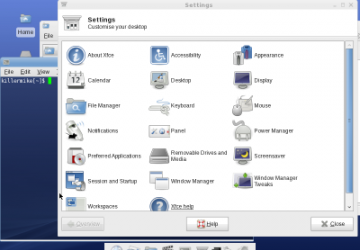Xfce 4.8 Desktop Environment

Although often classed as light-weight, Xfce qualifies as a medium weight amongst the Linux front ends. It's heavier than, say, LXDE or Window Maker but it uses less resources than KDE or Gnome. However, it is a desktop environment rather than simply a window manager, and as such, it comes with a set of associated utilities.
Actually obtaining and installing Xfce 4.8 proved to be a bit of an adventure in itself. At the time of writing, the Xfce devs haven't released any binaries, instead leaving this to the distributions themselves and other third parties. When I looked, all I could find was an Ubuntu 10.10 PPA that was 64 bit only. Compiling from source is daunting as it involves downloading and unpacking a collection of tar files and then building them in a special order. In the end, I installed a beta of Zenwalk, an Xfce orientated distribution. Take into account that I am therefore not basing my observations on plain, stock Xfce 4.8.
Behind the scenes, Xfce has dropped support for some older frameworks such as HAL in favor of GVFS and others in order to offer more modern, comprehensive hardware and networking support.
Thunar, the file manager, is probably the best known of all of the Xfce stand-alone applications, and it's an increasingly popular choice for use within other desktop environments. It is now possible to browse the network resources such as Samba shares and FTP sites, an improvement which will remove a long-standing barrier for a lot of people. It's also possible to eject removable devices from within Thunar. I presume that both of these advances have been made possible by the aforementioned move to a more modern set of frameworks. Progress indication for file operations now makes makes use of a single, shared window to avoid cluttering up the desktop.
The panel, an application launcher that sits at the bottom of the screen has been overhauled. Configuring the panel is now easier thanks to an improved configuration dialogue and the fact that you can now drag and drop applications onto the panel itself. It also has a pop up menu that allows you to browse the filing system in order to open terminals or file manager instances in the desired directory.
Xfce can now do quite a lot of the work of setting up the screen resolution and layout from within its configuration dialogues. It claims to be able to set up even multiple screens on a RandR compatible system. Unfortunately, this excludes systems using the proprietary Nvidia drivers. However, I presume that Nvidia's own GUI utility will work as normal in this case.
Poking around with it, it's clear that this version of Xfce offers a richer experience and better GUI configuration. A full featured but lightweight DE could be in much demand in future. Firstly, even thought version 4 has begun to stabilize and push forwards, a lot of people have become disenchanted with KDE. In addition, the next version of Gnome, version 3.0, is just around the corner, and it's possible that a percentage of users won't like the direction that takes.
For users who don't want to go truly minimalist or tiled, Xfce might be a good place to start when putting together a system. It's also a good GUI for systems that are basically command line setups with an occasional need for a full desktop. It may become an increasingly popular escape route for users who wished that Gnome and KDE had stayed small, and 2011 may become the year of the Xfce desktop for some.
XFCE website.










